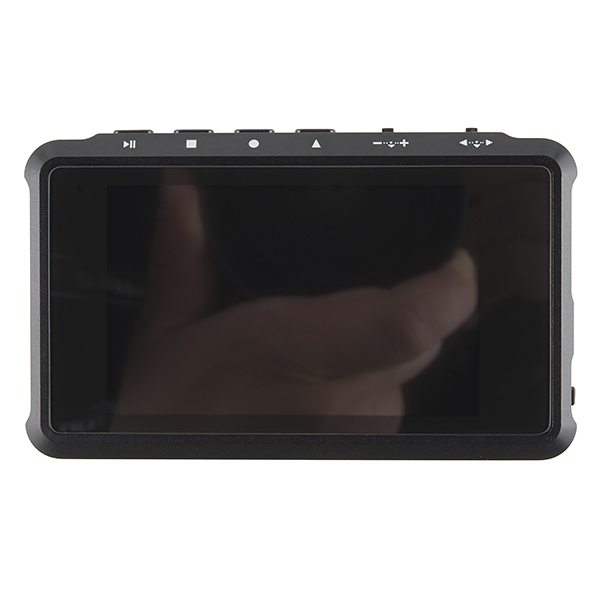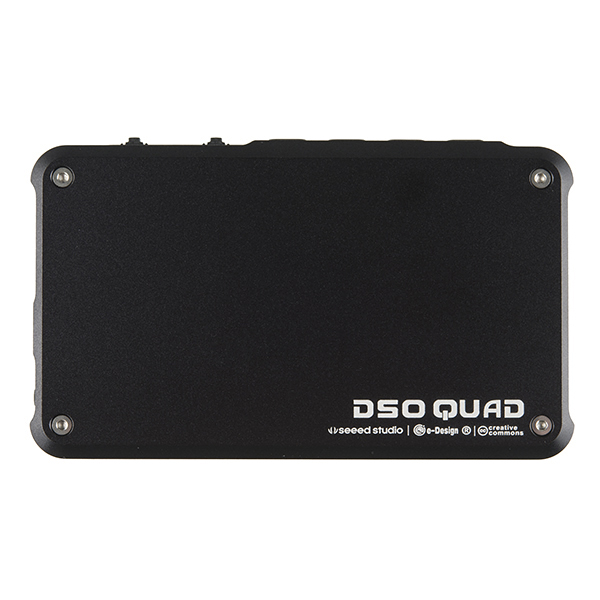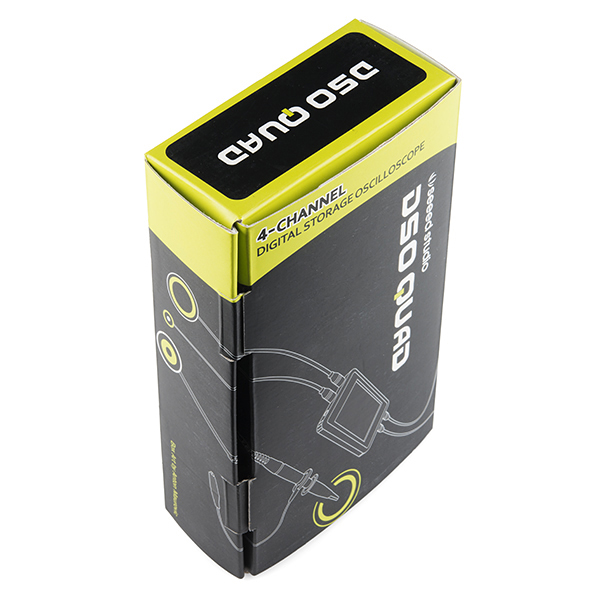DSO Quad - Pocket Digital Oscilloscope (Black)
The Black DSO Quad is an open-source pocket-sized 4-channel digital oscilloscope. It's based on the ARM cortex M3 32-bit platform, providing 72MS/s sampling rate with integrated FPGA and high speed ADC. The Internal 2MB memory can even store waveforms in various formats which you can transfer to your computer using a mini-USB cable.
Note: Check the link below for the most up-to-date firmware.
Note: This item may take longer to process due to battery installed in the equipment and therefore does not qualify for same-day shipping policy. Additionally, these batteries can not be shipped via Ground or Economy methods to Alaska or Hawaii. Sorry for any inconvenience this may cause.
Replaces:TOL-10388
- 2 Mueller MCX Osilloscope Probes
- 2 Digital Probes
- Li-Po Battery
- User Manual
- Portable (98x60x14.5mm)
- Two 72MS/s analog channels plus two digital channels
- 2MB Internal Storage
- 3" TFT LCD (400x240)
- 8-bit Vertical Resolution
- Signal Generator
- Auto Measurement
- Various Triggering Options
- Easy waveform storage
- Firmware upgradable
- User applications
- Open source
DSO Quad - Pocket Digital Oscilloscope (Black) Product Help and Resources
How to Use an Oscilloscope
February 25, 2014
How to work the dials and buttons on an oscilloscope, and a glossary of the o-scope lexicon.
Core Skill: Electrical Prototyping
If it requires power, you need to know how much, what all the pins do, and how to hook it up. You may need to reference datasheets, schematics, and know the ins and outs of electronics.
Skill Level: Experienced - You will need to consult a datasheet for calculations to determine a components output format, linearity, and do a little math to get what you need. You will be using a datasheet or schematic beyond basic pinouts.
See all skill levels
Comments
Looking for answers to technical questions?
We welcome your comments and suggestions below. However, if you are looking for solutions to technical questions please see our Technical Assistance page.
Customer Reviews
No reviews yet.








Is there a reason the scope bandwidth isn't clearly stated in the specifications?
Yes, because it is embarrassingly low. Based on an analysis of the circuit, the analog channels are 4.4MHz -3dB bandwidth. In addition, there are a lot of these scopes out there with an incorrectly specified TVS protection diode on the digital channels that limits their bandwidth to under 1MHz.
Also, this is NOT 72Msps per channel, It is dual 36Msps ADC converters.
Nyquist has nothing to say about bandwidth of a scope. Clearly, you cannot represent a sine wave with only two samples. It takes more like 8 or 10. That fits with a 4.4MHz bandwidth with 36Msps.
In addition, square waves require at least the 5th harmonic to approximate, more like 9th harmonic if you want any reasonable representation of the rise time. One of the requirements of a square wave is rise time. The rise time of the scope must be several times faster (shorter) than the rise time of the square wave, or it affects how the actual rise time is displayed.
There is another requirement with square waves: You are often using a scope on them to look for glitches, overshoot, and ringing. Those things will have a spectral bandwidth many times greater than that of the square wave. For that, the two digital channels are useless.
I consider a 4.4MHz scope barely adequate for audio work and sub100kHz digital signals.
The function generator is primitive. Sine, triangle, and sawtooth waveforms look like they are generated from only 3 or 4 bits of information, with big noisy steps between levels. They are stairstepped, is what I'm saying.
Over 20 years an Electronics Technician, and an Electronics Engineering Technician.
What this guy said.
Is this the one with the alloy case? It doesn't seem to say. If so, have they completely discontinued the plastic version. Other sites state if its alloy with a high voltage warning.
Comment retracted. If people want to waste their money, I'm not going to complain. Just read Member #458439's comment above first.
mikeselectricstuff has never reviewed this product... He reviewed the QDso which is a Cheap Chinese knockoff.
Despite its compact size, I wouldn't really classify the Rigol DSO1052E as a Pocket scope - which is pretty much the reason the DSO and a few similar products exist; to be vastly more portable. I suspect that they'll eventually be phased out in favor of smartphones/tablets (albeit with some hardware glue so as to let the smartphone/tablet essentially only act as the GUI and storage component) entirely, but for now... these are it.
Is there any new hardware or at least firmware packed in with these? I do have a DSO quad, and it is a handy little tool, but not a serious tool. I have noticed that, with the original firmware or with the custom firmwares I have tried, there is an issue with the time constant being wrong for some ranges of display. I might characterize this better when I get time. I do like some of the custom firmwares' expansion of this unit's signal generator capabilities; the pack-in firmware is rather limited.
Just ordered this for my birthday present. I wanted a heavy bag, but my wife said I had to get something practical. :)
Ideally the BW is defined as the -3dB point of the frequency response of the system. Sampling Theorem states that you need at least two samples per cycle in order to minimally figure out the frequency. This does not mean you can measure the amplitude! That is why when your working with digital signals you have to take into account all the harmonics that build up a waveform. In that case its common practice to need 5-10x the fundamental frequency in terms of the amount of samples.
The bandwidth should theoretically be 36 MHz, as the sampling rate is 72 Megasamples per second. Nyquist's theorem, I believe.
Incorrect. Nyquist/Shannon states that there should be NO appreciable (-60dB) energy content at 1/2 the sample frequency. So it is dependent on the quality of your filtering, which usually isn't much better than a 3rd or 4th order filter.
In this case, the lowest filter puts the -3dB point at about 4MHz.
Yes, what is the bandwidth on this? Looked on all the links but didn't see it anywhere. Based on rule of thumb for sample rates, it seems to imply between 18 and 24Mhz bandwidth, assuming real time sampling rates ???
Aww man! This would be crazy handy for my Christmas light hack!
Why is this $35 more than the white one? https://www.sparkfun.com/products/10388
Because the new cases are so pretty! I saw a contest somewhere that awarded, as a prize, this unit but with a milled, anodized aluminum case. It was quite handsome. It may have been the prototype for this unit.
that was the price of the white one, but now it's discontinued, so the price dropped.